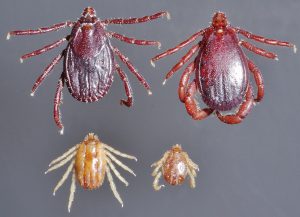 Ticks are a parasitic arachnid. Adult ticks have eight legs and are related to spiders and mites. Many people mistakenly call them insects, but no matter what you call them ticks can be a major nuisance. They carry serious diseases and can harm you, your loved one and your pets. Here are five facts about ticks.
Ticks are a parasitic arachnid. Adult ticks have eight legs and are related to spiders and mites. Many people mistakenly call them insects, but no matter what you call them ticks can be a major nuisance. They carry serious diseases and can harm you, your loved one and your pets. Here are five facts about ticks.
1. Number of Ticks
There are about 850 different species of ticks. Not all of them will carry diseases, but some do. Common ticks in the United States include the Lone Star tick, the blacklegged tick, the brown dog tick and the Gulf Coast tick. These ticks are found in the south and along the East coast.
2. Ticks Can Cause You to Develop Allergies
People have recently begun to develop allergies to beef and other meats after being bitten by the Lone Star tick. The Lone Star tick can be identified by the single dot on its back. The allergy will worsen overtime and may start out as simply feeling sick when eating red meat. Overtime it will worsen and can eventually get to the point where it causes anaphylactic shock. While it initially begins with just red meat, it can also develop into an allergy to poultry. People are allergic to the Alpha-Gal protein in the meat.
3. Ticks Have a Unique Feeding Process
Ticks need blood to advance through the different stages of their life cycle. Many ticks die because they are not able to attach to a host and drink their blood. Unlike other insects, ticks can feed for between 24 to 48 hours at a time. The tick may take up to 2 hours to attach to the host, but they often apply a glue-like substance to attach to the host.
4. Ticks Go Through 4 Stages
Ticks go through four different stages during their lifecycle. They begin as eggs, then hatch as larvae with just six legs. Ticks will then develop into nymphs with eight legs and finally mature into adult ticks that will lay the eggs. The entire lifecycle can take up to three years. As the ticks grow they will molt their shells as they grow bigger.
5. Ticks Lay Up to 4000 Eggs
Female ticks lay up to 4000 eggs during their lifetimes. Some species of ticks will lay all 4000 ticks at once, while other species will lay them in smaller batches. The tick must feed before laying the eggs, since they need the protein in the blood.
If you are worried about ticks bothering you or your pets, you can take the steps to prevent getting ticks. Treating your pet for ticks and fleas is just one step. Another option is to wear bug repellent when you go outside. You can also treat your yards for ticks. The experts at Mosquito Tek can apply a barrier spray that will keep your yard free from ticks all summer long.
Contact Mosquito Tek today to learn more, or go here to find out about flea and tick extermination: https://www.mosquitofreeliving.com/services/flea-tick-control/
Comments
Post a Comment